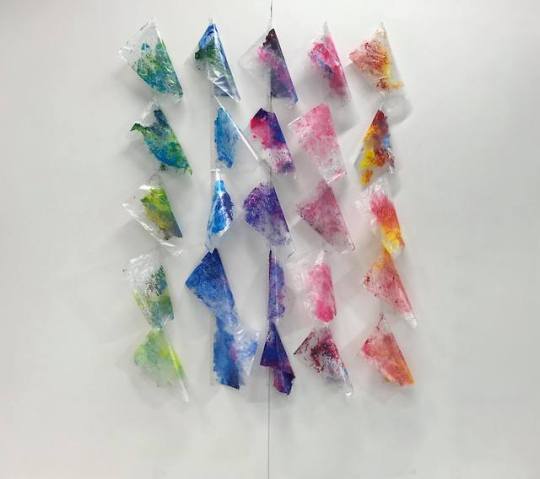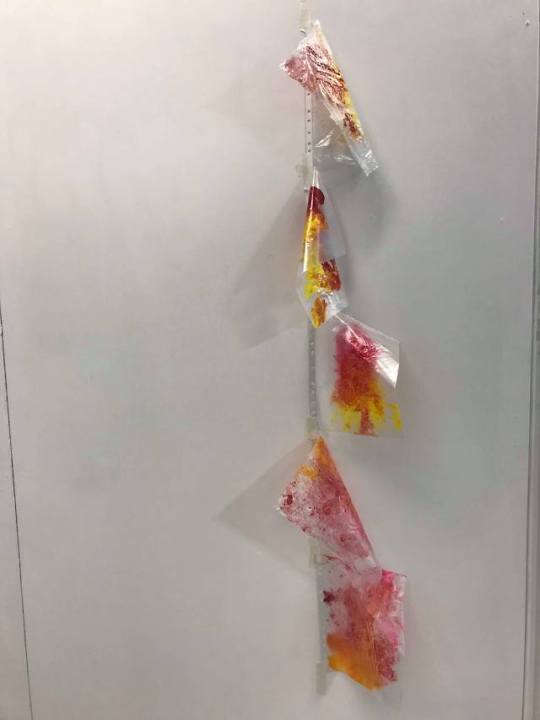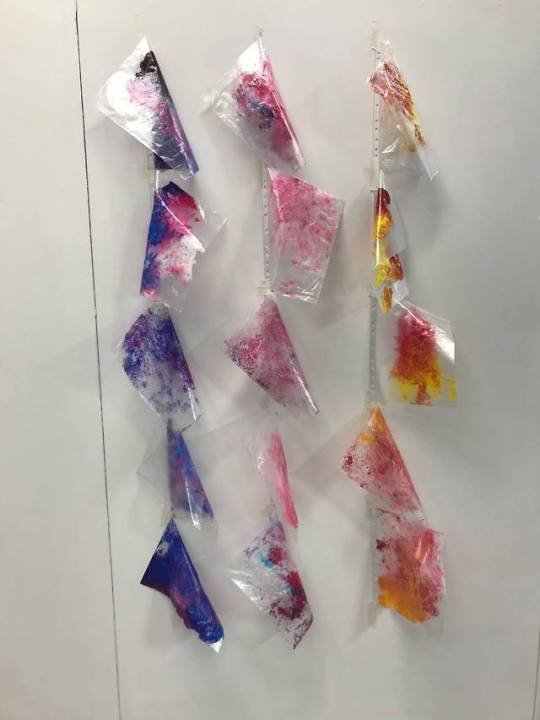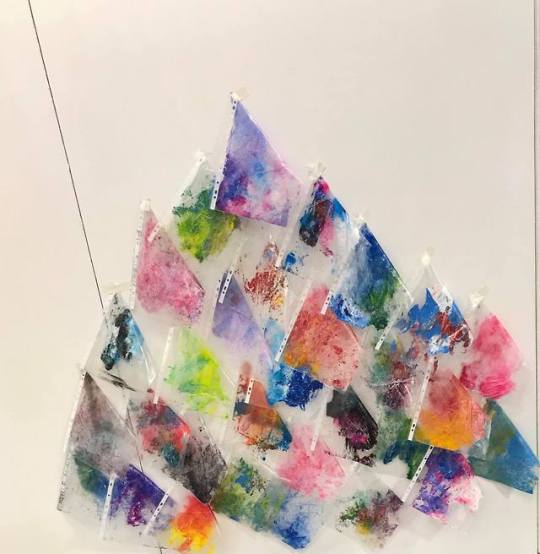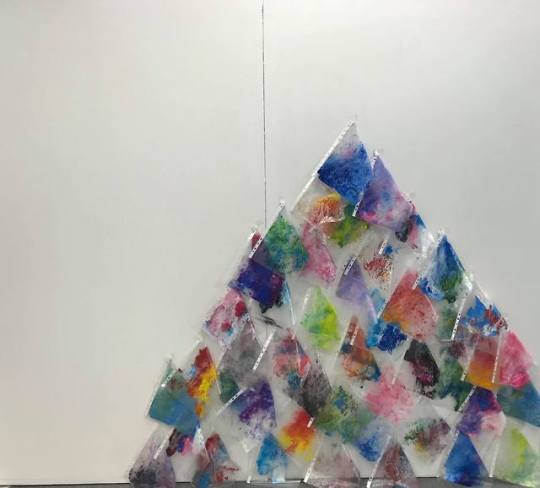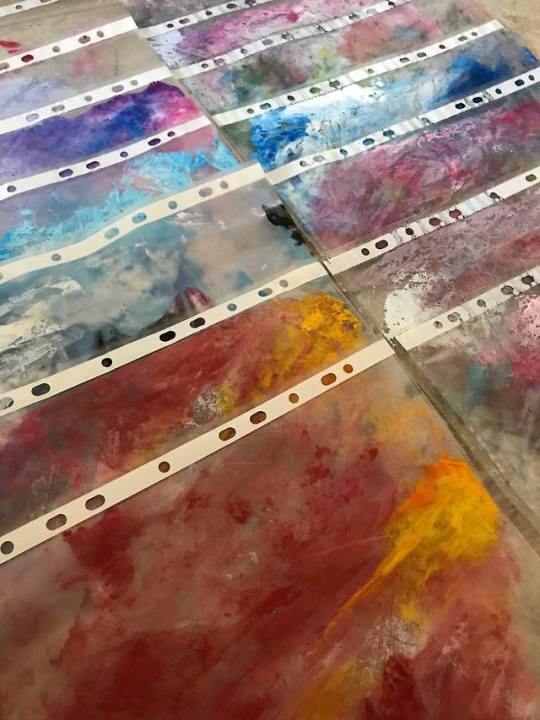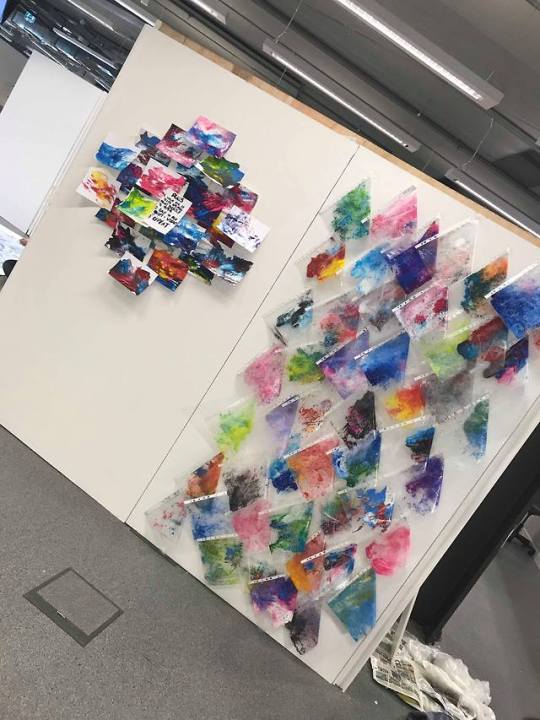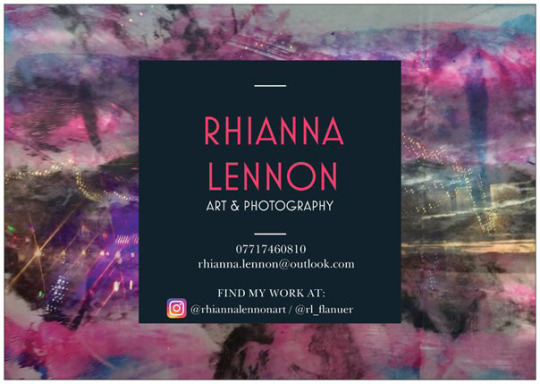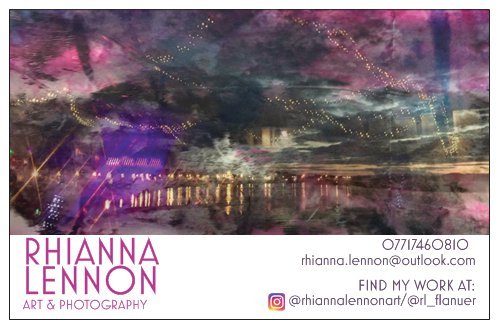Text
EVALUATION 2
The research process of the self-promotion module allowed me understand the importance of the planning and preparation required when participating in an exhibition – be it solo or as a group. Self promotion is just as important as exhibition promotion as promoting yourself as an artist will also promote your exhibition. I have been self promoting through the use of two Instagram accounts, which I update with new imagery as well as providing 'sneak peaks' at work that will be included in the exhibition which would generate interest for myself as an artist as well as the show itself. I feel my self promotion has been successful as I have generated interest and a small following over the course of a few months which has potential to grow and gain interest. Through creating business cards I have provided myself with a professional method of promoting myself that gives contact details as well as displaying my Instagram name where people can go to see more work and keep up to date with what I'm doing if they wish. Through this process I have learned important factors which will help me as an artist when I leave the college environment such as how to build up contacts and grow my network.
When it came to planning what I was going to display in the degree show I hit a blank. My proposal said that I would hang two paintings around A1 size, and to criticize my own thinking I should have realised that these were not my strongest work and didn't portray what my creative journey this year was. Through spending time in the exhibition space painting my walls and getting familiar with the space provided me with time to play around with placement and discuss with tutors and peers which is a crucial step in being part of a group exhibition. I allowed myself time to stay in the space and move work around and view it as other work was being installed which impacted the final placement of my work.
As my job within the self-promotion module is to manage stock for the shop I haven't been able to physically do anything yet as people aren't focusing on that fully until after their submissions. However, through researching pop-up shops I have discovered they can be very useful to artists as they create a “get it while it lasts” urgency meaning that people may be more likely to buy your work as they feel they wont get the opportunity again. This research will be beneficial when setting up the shop as they layout and management of it will be crucial to the successfulness of it.
Overall, I'm disappointed in myself as I wasn't very involved with the starting planning stages of the exhibition which severely impacted my ability to contribute and provide helpful insights to some key stages in the degree show process. I feel I had some good ideas and strategies I could've suggested however it was too late when I was able to do so. However, I realise how important these stages are and tried to rectify this in the end by spending time in the space to ensure that my work doesn't intrude on anyone else's and doesn't detract from the professionalism of the exhibition as a whole.
Word count: 549
0 notes
Photo
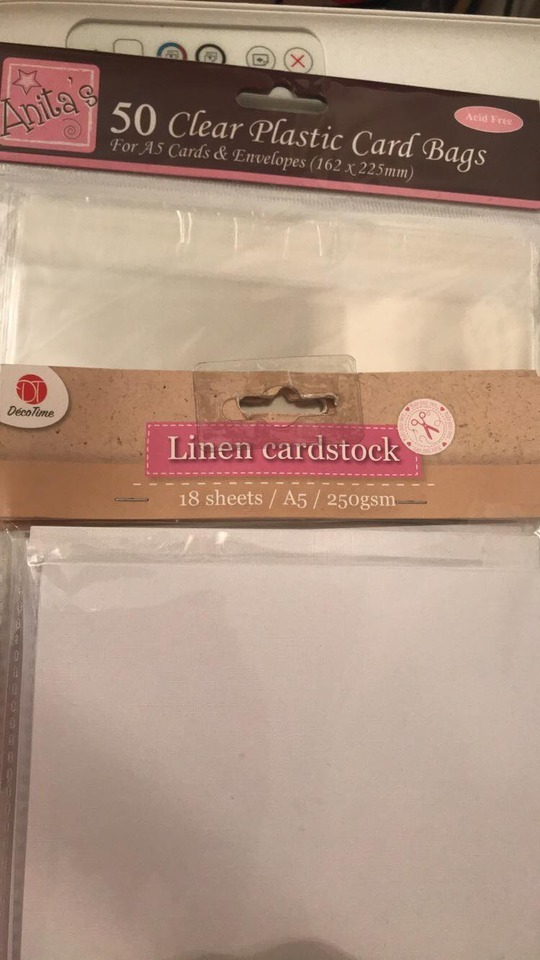

Organising prints - paper and bags and some test/misprints. I wanted to do the prints myself as it was cheaper and I’m in control of what the prints look like.
0 notes
Link
0 notes
Link
Article about pop-up shops however the information could also be used in relation to an exhibition - solo or group.
0 notes
Text
Approaching gallery curators:
Gallery curators have friends in the art world (tutors, critics, art journalists, gallery owners) that may be able to influence what exhibitions and artist’s studios they go to see. This is one of the reasons that growing your network is so important as an artist. Through ‘six degrees of separation’ someone you know may recommend your show or work to a gallery/curator.
Think of the reputation of any group shows you get involved with – every show you are in is a reflection of your work.
Many curators go to open studio exhibitions, as they can see large numbers of artists’ work at one time.
Curators are happy to visit artists’ studios if they have time, but hassling them about a visit will not help.
If it was really as easy as sending off images to galleries to get an exhibition, everyone would have exhibitions all the time. Ask your friends how many of them have received exhibition offers after sending unsolicited applications, and then how much time they have spent on making such applications.
0 notes
Text
Things to think about when planning a pop up shop
Exterior
What is the potential target market foot-traffic in the area?
Who are the other notable retailers and consumables in the area and are they complementary?
Are there events or community gatherings taking place in the vicinity?
Is the retail space in a nondescript building with a small entrance sign, or does the building have a grand entrance with a large logo?
What’s the cleanliness level like?
Is there parking nearby?
Is the location accessible by public transit?
Is there a large window that you can dress up for a display?
Interior
Is there back stock space?
What does the lighting communicate? Can lights be dimmed or alternative lamps and lighting brought in?
Is there a camera to prevent theft and shrinkage? If not, what other loss-prevention tactics can be made available?
Is there Wi-Fi to carry out credit card transactions with your POS solution? Can it be made available to customers?
Is there a sink and toilet?
0 notes
Link
A website that allows you to find places that you can set up a pop up shop - good for artists to sell their work
0 notes
Text
WHY RUN A POP UP SHOP?
https://www.shopify.co.uk/guides/ultimate-guide-to-pop-up-shops/why-run-a-pop-up
1. Test a New Revenue Stream
If you're an ecommerce business, pop-up shops provide a relatively low-cost way to explore adding an additional revenue stream. Not only is it a fraction of what you'd pay for an actual physical retail location, if the concept is executed and popularized well, you could rake in a significant profit.
2. Engage Customers Offline
You've heard it before, but not being able to try on a product before purchasing can be a very real pain point. To be honest, there’s just something about being able to physically touch a product before you buy which makes the shopping experience very enticing for consumers. To further validate the idea, a recent study by Accenture showed that 78% of shoppers are “webrooming” (browsing online, then purchasing in a store) today.
3. Create “Get It While It Lasts” Urgency
The beauty of a pop-up shop is that it's a limited window of time for consumers to engage with your brand and purchase your products. The idea that you're not going to be around for long is a huge plus point in getting customers to buy. Scarcity drives action through customers wanting exclusive, limited edition, or other products they can't get otherwise, and a pop-up shop puts you in a perfect position to take advantage.
4. Market Merchandise Around a Sale, Season, or Holiday
There's nothing like jumping on the holiday bandwagon, especially when you factor in how much people spend on their loved ones. It doesn't matter if you're looking to sell dresses for New Years, flowers on Valentines, costumes on Halloween, or kitchenware on Thanksgiving, tying your brand closely with a holiday and giving consumers a physical location to access you is a great way to be opportunistic and make a significant amount of cash.
5. Educate New Customers
When you’re trying to sell a crazy new invention that hasn’t crossed over into the mass consumer subconscious, a pop-up shop can help you understand how your existing marketing collateral performs with actual customers while getting real-time feedback on how it can be improved. Even if you’re just looking to drive pre-orders before going full throttle on manufacturing, giving your potential customers a live demo or walking them through how your product works is a great way to get through to those early adopters.
Another scenario is when you've got a product that makes people scratch their heads, like beard oil for urban beardsmen, or plastic wrap alternatives made out of beeswax, pop-ups can be an effective way to demonstrate the value of your product and get people intrigued enough to either become customers on the spot or solid prospects.
6. Go to Where Your Customers Are
This is an especially strong reason to do a pop-up shop when you've perhaps had some experience selling online and have a good idea of your customer profile that allows you to identify the areas or locations that they're most likely to frequent. The benefit of being able to select a certain side street, kiosk, or vacant gallery space is that you can match your wares with the personality of a given demographic and go to where they go.
7. Generate Brand Awareness
Let's face it, the competition to market and sell online is become just as stiff as offline retailing. Which is why having a one-two punch approach is where the entire retail industry is heading through an omultichannel presence. By engaging prospective customers offline and delighting them with an unforgettable experience and quality products, you can then point them to your online site and social accounts, where they can stay in touch and continue to buy your wares.
0 notes
Text
DEGREE SHOW PROMOTIONAL STRATEGY
In order to ensure our exhibition is well organised and promoted, jobs must be allocated to each person to split the workload. Through weekly meetings we discuss and share our findings and research and can keep each other up to date on what is happening and what needs to happen.
The jobs list is:
Studio prep: ALL STUDENTS
Install/destall: ALL STUDENTS
Exhibition Curators: Emma & Claire
Marketing: Alex & Jamie M
Volunteer Co-ordination: Louise & Carol
Invigilation Co-ordination: Fraser
Open night (catering); Shahida
Mailing List: Fiona
Poster Distribution: ALL STUDENTS
Catalogue: Jamie Mc & Lauren
Exhibition Co-ordinators: Gayle & Paul
Poster Generation: Jamie Mc & Lauren
Sponsors: Toni
Pop up shop/stock: Rhianna & Lynsey
Artist Talks: Rebecca
Through research into pop up shops we need to ensure that everything is well presented and easy to understand. We will need to organise a space as well as think about what we will need for people to display their work on. When the time comes to set up the shop, all students will need to provide us with a list of everything they are placing in the shop so that we can manage stock and ensure nothing goes missing or is left unaccounted for. In addition to this, we will need to manage money and where this is going to be kept. A rota will be required for manning the shop as it can't be left unattended as this allows for people to steal things or for items to get damaged.
0 notes
Text
“Not paying artists deeply entrenched in gallery culture” - Article in the Guardian
A-n represents 18,000 artists, from emerging talent to people nominated for the Turner prize. More than a 1,000 were surveyed revealing:
• 71% taking part in publicly funded exhibitions received no fee
• Of those, 59% did not get their expenses paid
• 63% have turned down gallery requests to exhibit because they cannot afford to work for nothing
• 72% of artists made less than £10,000 in a year from their art practice.
0 notes
Quote
more than 70% of contemporary visual artists who took part in publicly funded exhibitions in the last three years received no fee. Almost as many are now saying no to galleries because they cannot afford to work for free
https://www.theguardian.com/artanddesign/2014/may/26/not-paying-artists-gallery-culture-publicaly-funded-exhibitions
0 notes
Quote
If publicly-funded galleries satisfy themselves with working with the minority of artists who have 'made it' by showing their work in exhibitions, we run the risk of a monocultural art world in the UK where the same artists are seen at every regional gallery, and where our galleries' unique sense of place and identity is traduced by the authority, effectively, of London's art world
https://www.a-n.co.uk/research/exhibitions-are-not-enough-publicly-funded-galleries-and-artists-professional-development-3/
0 notes
